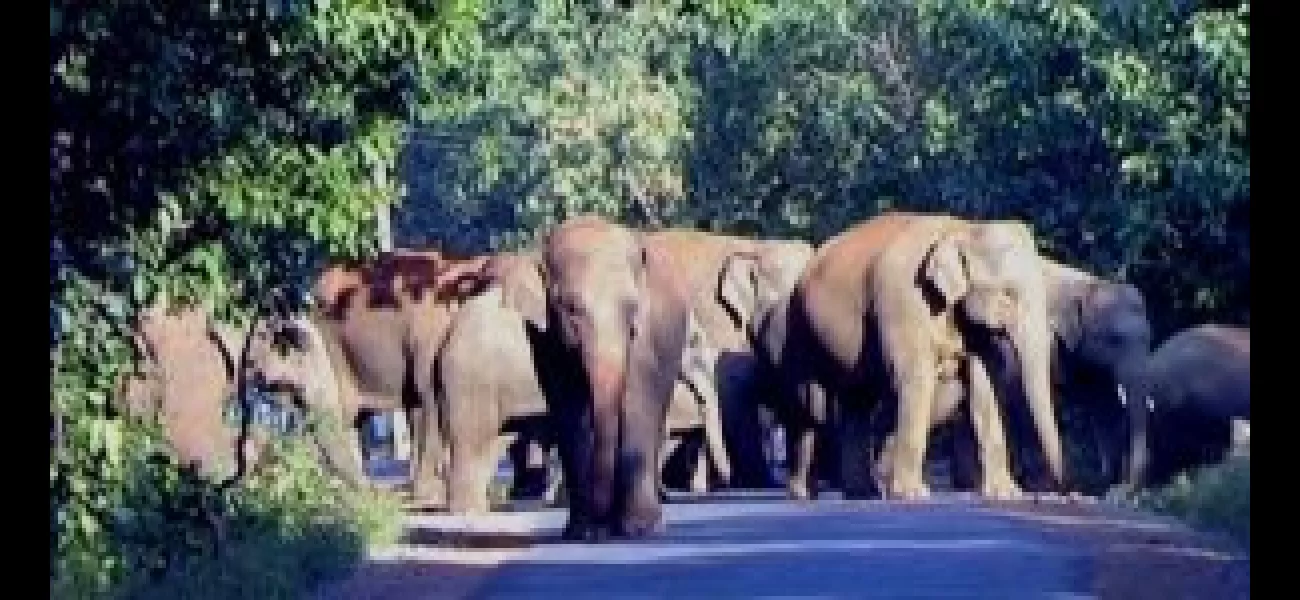Despite increased population, elephants in state still in danger.
The elephant population in Odisha has grown in recent years but the state still sees many elephant deaths, according to the All Odisha Elephant Census.
August 12th 2024.

Bhubaneswar, a city in the state of Odisha, has seen a positive increase in the number of elephants in recent years. However, despite this growth, the state still faces a significant number of elephant deaths. According to the All Odisha Elephant Census in 2024, there are now 2,098 elephants in the state, an increase of 122 in the last seven years. Unfortunately, between April 1 and July 15 of this year alone, the state has lost 27 elephants due to various reasons such as electrocution, conflicts with humans, and train accidents.
The Parliament has reported that these elephant deaths occurred in 15 different forest and wildlife divisions, with Angul recording the highest number of deaths at four. Not only are elephants facing danger, but humans are also at risk. In the last four years, 1,701 humans in 16 states were killed by elephants, with Odisha accounting for 148 deaths in 2022-23, the highest in India. These alarming statistics were presented by the Union Environment Ministry in Parliament. Sangita Iyer, a wildlife filmmaker and founder of Voices for Asian Elephants, an organization dedicated to elephant conservation in Odisha, expressed concern over the situation. Despite the 6% rise in the elephant population, the state is still facing challenges in protecting these majestic creatures. Iyer explains that electrocution is currently the leading cause of elephant deaths in Odisha, as poachers continue to use high-voltage power to kill them.
To address the issue of human-elephant conflicts, VFAE, a California-based elephant conservation organization, has taken action by planting over 50,000 fruit trees and digging seven large watering holes in partnership with a local conservation group called 'Paribartan' in Balasore and Angul districts. These efforts can support approximately 210 elephants and help reduce their need to venture into villages in search of food and water, which ultimately leads to conflicts with humans. Iyer emphasizes the importance of restoring degraded habitats with preferred elephant plant species and creating waterholes to prevent elephants from crossing dangerous roads.
She also highlights the vital role elephants play in protecting our environment and the need for all stakeholders to work together to find solutions before it's too late. As we celebrate World Elephant Day, she urges everyone to acknowledge and address their mistakes and come together to protect these gentle giants. In an interview with Orissa POST, Susanta Nanda, Principal Chief Conservator of Forests, explains that although the elephant population has increased, the state does not have enough space to accommodate a large number of them. He mentions that the ideal capacity for Odisha is between 1,700 and 1,800 elephants and emphasizes the importance of population management to reduce deaths and conflicts with humans.
Nanda also shares the measures being taken to control elephant deaths, such as using artificial intelligence to detect elephant movement. He adds that trials will be conducted in Angul and Dhenkanal soon. The state is determined to address this issue and ensure the safety of both elephants and humans. As we reflect on World Elephant Day, let us remember the vital role these animals play in our ecosystem and work towards their protection and preservation.
The Parliament has reported that these elephant deaths occurred in 15 different forest and wildlife divisions, with Angul recording the highest number of deaths at four. Not only are elephants facing danger, but humans are also at risk. In the last four years, 1,701 humans in 16 states were killed by elephants, with Odisha accounting for 148 deaths in 2022-23, the highest in India. These alarming statistics were presented by the Union Environment Ministry in Parliament. Sangita Iyer, a wildlife filmmaker and founder of Voices for Asian Elephants, an organization dedicated to elephant conservation in Odisha, expressed concern over the situation. Despite the 6% rise in the elephant population, the state is still facing challenges in protecting these majestic creatures. Iyer explains that electrocution is currently the leading cause of elephant deaths in Odisha, as poachers continue to use high-voltage power to kill them.
To address the issue of human-elephant conflicts, VFAE, a California-based elephant conservation organization, has taken action by planting over 50,000 fruit trees and digging seven large watering holes in partnership with a local conservation group called 'Paribartan' in Balasore and Angul districts. These efforts can support approximately 210 elephants and help reduce their need to venture into villages in search of food and water, which ultimately leads to conflicts with humans. Iyer emphasizes the importance of restoring degraded habitats with preferred elephant plant species and creating waterholes to prevent elephants from crossing dangerous roads.
She also highlights the vital role elephants play in protecting our environment and the need for all stakeholders to work together to find solutions before it's too late. As we celebrate World Elephant Day, she urges everyone to acknowledge and address their mistakes and come together to protect these gentle giants. In an interview with Orissa POST, Susanta Nanda, Principal Chief Conservator of Forests, explains that although the elephant population has increased, the state does not have enough space to accommodate a large number of them. He mentions that the ideal capacity for Odisha is between 1,700 and 1,800 elephants and emphasizes the importance of population management to reduce deaths and conflicts with humans.
Nanda also shares the measures being taken to control elephant deaths, such as using artificial intelligence to detect elephant movement. He adds that trials will be conducted in Angul and Dhenkanal soon. The state is determined to address this issue and ensure the safety of both elephants and humans. As we reflect on World Elephant Day, let us remember the vital role these animals play in our ecosystem and work towards their protection and preservation.
[This article has been trending online recently and has been generated with AI. Your feed is customized.]
[Generative AI is experimental.]
0
0
Submit Comment





